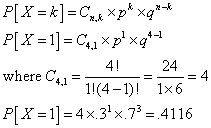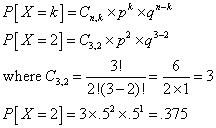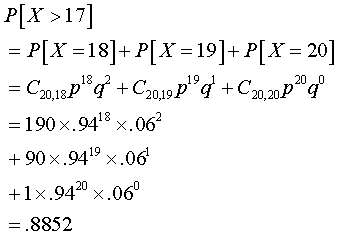To compute a binomial probability, you need to calculate and multiply three separate factors:
- the number of ways to select exactly k successes,
- the probability of success (p) raised to the k power, and
- the probability of failure (q) raised to the (n-k) power.
Since success and failure are the only two possibilities, q = 1 - p. The probability of k successes in a binomial(n,p) distribution is:

The exclamation point is mathematical notation for factorial. You compute a factorial by multiplying all the integers in sequence from one up to the number. For example,
![]()
The value of 1! is, intuitively, equal to 1. The value of 0! is, not so intuitively, equal to 1 also. Here are some examples:
X=number of successful transplants is binomial(4,0.3). What is the probability of exactly one successful transplant?
X=number of girls is binomial(3,0.5). What is the probability of exactly two girls?
X=# of vaccinated volunteers with flu resistance is binomial(20,0.94). What is the probability that more than 17 of the volunteers will develop resistance?
The calculations in the last example are a bit tedious, which is why most statisticians rely on computers.



